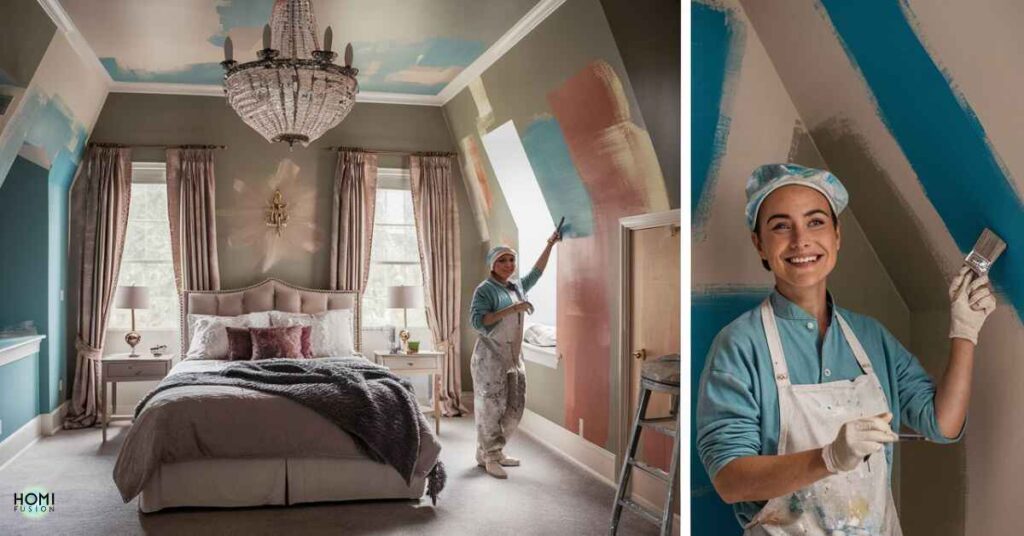Painting a bedroom can transform its ambiance and add a personal touch to your living space. However, one common question that arises is the time it takes to complete this task.
Factors such as the size of the room, the type of paint used, preparation work involved and the application method significantly impact the duration.
Understanding these variables and planning accordingly ensures a smooth and efficient painting process, delivering the desired results within a reasonable timeframe.”
The Size of the Bedroom
The size of your bedroom plays a crucial role in determining the time needed for painting. Larger rooms naturally require more time as there is a greater surface area to cover. Additionally, intricate features such as vaulted ceilings or multiple windows can add complexity to the painting process, further extending the timeline.
Conversely, smaller bedrooms with fewer obstructions may be completed more quickly. It’s essential to assess the size of your bedroom accurately to plan for an efficient painting schedule.
The Condition of the Surfaces
Before diving into painting, evaluating the condition of the surfaces is paramount. Smooth, well-prepared walls and ceilings typically facilitate faster painting compared to surfaces with imperfections such as cracks, dents, or peeling paint.

Addressing these issues beforehand through proper surface preparation, including cleaning, patching and priming, not only enhances the final result but also contributes to a smoother painting experience. Factor in time for surface inspection and necessary repairs to achieve a flawless finish.
Priming Walls Before Paint
Priming walls before painting is a crucial step that shouldn’t be overlooked. It helps create a smooth and uniform surface, enhances paint adhesion, and ensures better coverage, especially when transitioning between different paint colors or covering stains.
Depending on the condition of the walls and the type of paint being used, priming may add an extra day or two to the overall painting timeline. However, this step significantly contributes to the durability and quality of the final paint job.
Painting the Ceiling and Trim
Painting the ceiling and trim requires attention to detail and precision. These areas often require different techniques and may need additional coats for optimal results. The time needed for painting the ceiling depends on its size, height, and whether any repairs or priming are required.

Similarly, painting trim involves intricate work around corners, edges and moldings, which may extend the overall painting duration. Properly painting these elements contributes to the overall aesthetic appeal and cohesiveness of the room’s design.
Read this blog: How High Is A TWo Storey House
How Much Prep Work Needs to Be Done?
Effective preparation work sets the foundation for a successful painting project. Assessing the amount of prep work needed involves factors such as repairing cracks or holes, sanding rough surfaces, cleaning walls, and removing old paint or wallpaper.
The extent of prep work directly influences the overall painting timeline, as thorough preparation ensures a smooth and long-lasting finish. Investing time in preparation saves effort during the painting process and contributes to a professional-looking outcome.
Do You Need Multiple Coats of Paint or Just a Touch-Up?
Determining whether multiple coats of paint or a touch-up suffice depends on various factors like the current paint condition and desired color change. It also hinges on the quality of paint chosen, impacting coverage and durability of the final result.

While a touch-up may be suitable for minor blemishes or color corrections, significant color changes or damaged surfaces may necessitate multiple coats for proper coverage and durability. Choosing the right approach minimizes rework and ensures a satisfactory end result, impacting both the timeline and quality of the painting job.
The Quality and Type of Paint
The quality and type of paint selected significantly impact the overall painting process. High-quality paints offer better coverage, durability and color retention, reducing the need for multiple coats and touch-ups. Understanding paint sheen levels, such as flat, eggshell, satin, or semi-gloss, is also crucial as they affect the room’s appearance and maintenance.
Moreover, certain paint types like latex or oil-based paints have different drying times. These variations also affect application techniques, influencing the overall painting timeline and outcome. Choosing the appropriate paint quality and type is essential for achieving desired results efficiently and effectively.
What Application Methods Will You Be Using to Paint the Room?
When painting a room, the application method plays a crucial role in achieving the desired finish and efficiency. Understanding the pros and cons of different application methods helps in making informed decisions for your painting project.
Paint with Roller

Using a roller for painting offers several advantages, including efficient coverage of large surface areas, smooth finishes on walls, and ease of application. Rollers are suitable for walls and ceilings and are particularly effective for applying paint evenly over flat surfaces.
Paint with Sprayer
Painting with a sprayer provides fast and even coverage, making it ideal for large areas or textured surfaces. Sprayers can achieve a smooth finish without brush or roller marks, saving time and effort. However, they require proper technique to control overspray and ensure precise application.
Paint with Brush
Brush painting offers precision and control, making it suitable for trim, edges and detailed work. Brushes allow for smooth lines, blending colors seamlessly, and reaching areas where rollers or sprayers may not be practical. While brush painting may take longer than other methods, it delivers meticulous results, especially for intricate or small spaces.
Painting Experience
Your painting experience directly impacts the time and quality of the painting project. Experienced painters may work faster and achieve smoother finishes compared to beginners. Consider your skill level and whether you need assistance or professional guidance for optimal results.
Paint Drying Time Depends on Weather Conditions

The drying time of paint varies based on weather conditions such as humidity, temperature and airflow. Warmer and drier climates typically facilitate faster drying, while cold or humid conditions may prolong drying times. Understanding how weather affects paint drying helps in planning your painting schedule and ensuring proper curing for a durable finish.
Self Paint
Opting to paint the room yourself can be a rewarding experience, allowing you to customize the space and save on labor costs. However, self-painting requires time, effort, and attention to detail. Consider your schedule, skills and the complexity of the project before deciding to self-paint or hire professional painters.
Also read: What Is A Garden Home?
Contract for Paint
When hiring professional painters, a contract outlines important details such as scope of work, timelines, costs and warranties. Reviewing and signing a contract ensures clarity, protects both parties’ interests, and sets expectations for the painting project.
Collaborating with reputable contractors ensures a smooth and satisfactory painting experience.
Frequently asked questions
Can you paint a bedroom in one day?
Yes, painting a bedroom in one day is feasible for smaller rooms with minimal prep work and efficient painting techniques.
Can you paint a room in 2 hours?
Painting a room in 2 hours is possible for very small rooms with simple layouts, limited surfaces to paint, and quick-drying paint.
How long should it take to paint a 10 x 12 room?
Perimeter of a room= 10’x 12′
Total perimeter = 10 +12 x 2 =44’
Height of ceilings = 12’
Total Area = 44x 12 = 528’
Calculation of time = 528’ x 1.125 minute= (528x 1.125 = 594 minute)
Convert the time into hours =(594 minutes / 60 = 9.9 hours)
How long does it take professional painters to paint a room?
Professional painters can usually paint a room in 1-2 days, depending on factors such as room size, prep work needed, and the number of coats required.
Is it OK to sleep in a room after painting?
It’s generally recommended to wait at least 24 hours after painting before sleeping in a freshly painted room to allow the paint fumes to dissipate and ensure proper ventilation.
Conclusion
Painting a bedroom involves multiple considerations such as room size, surface condition, paint type, application methods, and personal expertise. Understanding these factors helps in planning and executing a successful painting project.
Whether opting for DIY painting or hiring professionals, time estimates vary based on the complexity of the job. Proper preparation, including priming surfaces and choosing the right paint quality, contributes to a durable and visually appealing finish.
Additionally, considering factors like paint drying time and post-painting precautions, such as ventilation for fume dissipation, ensures a safe and comfortable environment. By addressing these aspects thoughtfully, one can achieve desired results while minimizing disruptions and maximizing the longevity of the paint job.







